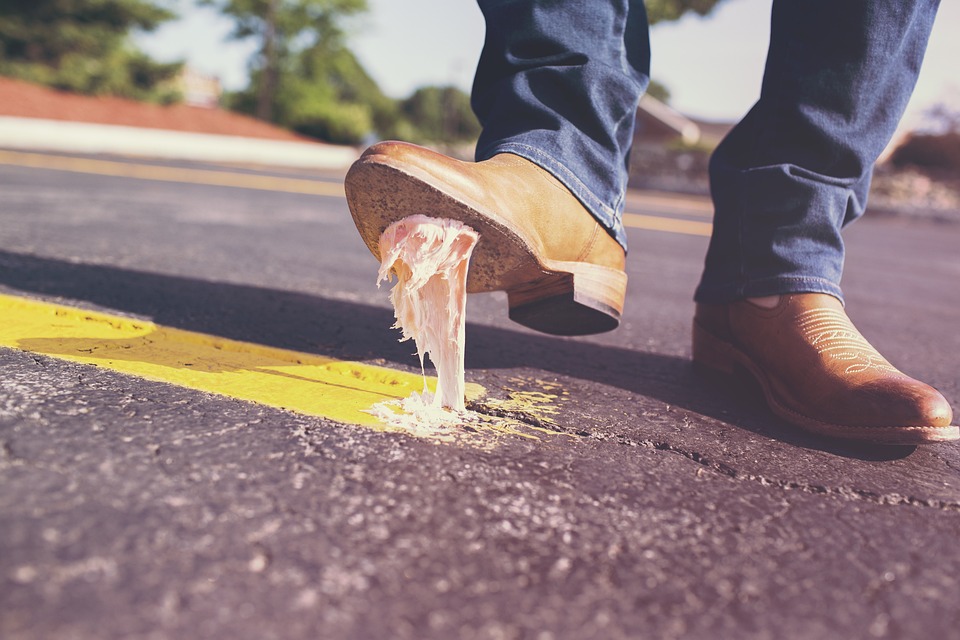Unknowingly, you are doing certain things that are leaving their impact on our environment. Let’s find out more!
Throwing Chewing Gum on the Ground
 Gum sales date from the 1800s in the US and soon became widespread. Today, the global chewing gum market is valued at approximately US$ 27 billion. Recent statistics show that people of all ages are most likely to chew gum at least two or three times a week. In fact, studies have revealed that an average American can chew at least 1.8 pounds of gum yearly.
Gum sales date from the 1800s in the US and soon became widespread. Today, the global chewing gum market is valued at approximately US$ 27 billion. Recent statistics show that people of all ages are most likely to chew gum at least two or three times a week. In fact, studies have revealed that an average American can chew at least 1.8 pounds of gum yearly.
Despite the fact that chewing gum can have adverse side effects like headaches and jaw pain, it has become a common habit for a lot of people. People would chew gum as a means to reduce stress, quit smoking and reduce food cravings.
Whether chewing gum is helping you break a bad habit or curbing your bad breath, it is important to know that 80-90 % of chewing gum is not disposed of properly and it is a common form of litter that affect the environment.
If you live in big cities, you’ve probably seen hundreds of pieces of old chewing gum stuck to the pavement. The flavor of chewing gum might be sweet, but you’ll eventually have to throw it away. So, how do you dispose of it once when you are done?
Your answer: Throw it in a bin.
But, what really happens: You throw it on the ground.
Chewing gum is made of polymers –synthetic plasters that are not biodegradable. When a piece of gum is thrown on the sidewalk, it sits there until it is removed, which might never happen.
Of course, you can buy sustainable chewing gums which are made from biodegradable substances.
Using a Hair Straightener
 Everyone’s heard of an inferiority complex, but have you ever heard of a “hair complex?”
Everyone’s heard of an inferiority complex, but have you ever heard of a “hair complex?”
Today, it’s very common for people to compare their hairstyles to others and want to “fix” the hair they don’t like. Some women with frizzy or curly hair, for example, have a tendency to straighten their hair on a daily basis.
Straight hair is very popular and trendy because it can be shaped into different styles and looks. However, this hair-strengthening obsession is lethal as it contributed to an industry that generates toxic fume and maims and kills thousands of animals a year.
With today’s heightened awareness of global warming, it is surprising that many people are not aware of the high energy consumption of hair straighteners. These hair tools take up lots of energy and therefore add more carbon dioxide to the atmosphere.
Human Farts
 If you like reading, you must have read that cow farts are bad for the environment. But, what about human farts?
If you like reading, you must have read that cow farts are bad for the environment. But, what about human farts?
Flatulence is a completely normal biological process that occurs with everyone regularly. While some may fart only a few times a day, others can pass wind about 5 to 15 times per day.
You see, human farts consist of methane and some other greenhouse gases, which are not good for the environment. However, if you look at the bigger picture, human farts are just a tiny component compared to fossil fuel emissions.
Watching Videos in HD
 I bed your pardon?
I bed your pardon?
If you take a look at YouTube videos from 2008, for example, you’ll find the quality to be very low. Watching videos in high-definition (HD) or Ultra High Definition (UHD) is very common among movie buffs and gamers. However, according to some scientists, watching movies in HD or UHD might not be a good option for the environment.
Why?
In general, it is said that digital technology has contributed to an increase of 1.4 % in global emissions. According to a study led by scientists at the UK’s Royal Society, watching a video in HD on your phone can generate eight times the carbon emissions as watching the same video in standard quality.
So, would you be willing to stream in SD to save the environment?
